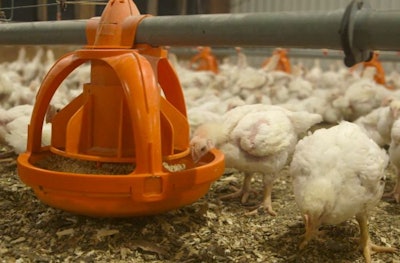
In Egypt, the speaker of the House of Representatives is the latest high-level government representative to call for a solution to the current crisis affecting the nation’s poultry industry.
Addressing the House agriculture committee, Hanafy Gebaly called a meeting of ministers and the Central Bank of Egypt to help the sector, reported the State Information Service.
Over recent days, Prime Minister Mostafa Madbouli has directed a number of agencies to cooperate to bring stability to Egypt’s poultry industry, according to the same source.
He called on the agriculture minister and representatives of the Central Bank of Egypt and the national poultry association to arrange for the regular release of feed ingredients.
Previously, the agriculture minister had pledged to support the industry achieve self-sufficiency in the production of poultry meat and eggs. Ultimately, the industry aims to be in a position to export these products. In order to achieve these goals, Minister el Sayyed el Quseir confirmed the availability of low-interest loans to new industry entrants.
According to deputy director of the Central Bank, 122,000 metric tons of soybean meal was released to produce feed earlier this month. Furthermore, corn valued at US$40 million has also been made available.
Power of social media
Prompting the addressing of the industry’s woes at the highest level appears to be a video clip of the culling of young chickens. This went viral, reported Arab News, sparking outrage in Egypt, including for criminal punishment for the birds' inhumane treatment.
In response, the Egyptian Poultry Association explained that the cull arose from desperation at the severe shortage of poultry feed.
The head of the Poultry Division of the Egyptian Chambers of Commerce described the situation as a “disaster” that could see the end of the nation’s poultry industry.
To calm the situation, the prime minister called the meeting to address the feed ingredient shortage without allowing opportunities for black market trading.
Cairo 3A set to double chicken output
One month ago, Egyptian poultry company Cairo 3A announced it plans to double its chicken output by next year, reported Zawya.
According to the firm’s deputy chief executive, Cairo 3A has recently invested in the construction of an automated slaughterhouse at a cost of 151 million Egyptian pounds (EGP; US$7.7 million). This will support the increase in output from nine million birds last year. Already in its final stages is the firm’s new feed-mill near completion in Sadat City.
As a result of the Russian invasion of Ukraine, production costs have risen by 40%, he said.
The firm’s current annual capacity is 60 million birds, according to the executive, making Cairo 3A among the country’s leading poultry companies.
An integrated poultry producer, Cairo 3A was founded in 2017. In 2020, it expanded production by purchasing a 50% share of Pyramid Poultry.
Earlier this year, the company announced final plans for the construction of a modern hatchery.
Developments in Egyptian poultry sector
To support the growth of the domestic poultry sector, Egypt’s agricultural bank announced in 2020 the availability of low-interest loans to support expansion in the country’s poultry meat and egg output.
That same year, Egypt produced just over one billion broilers or around 1.34 million metric tons of chicken meat, according to the statistics arm of the United Nations’ Food and Agriculture Organization, FAOstat. 2020 is the latest year for which figures have been published.
In a market analysis published earlier this month, the USDA Foreign Agricultural Service (FAS) forecasts a near-1.9% year-on-year increase in feed consumption by the Egyptian poultry sector in 2022-2023.
According to this source, likely drivers of the trend are greater consolidation by larger producers, more vertical integration, and a decline in corn prices. Furthermore, FAS expects feed production to rise as a result of more feed lines coming into production at existing feed mills.

















